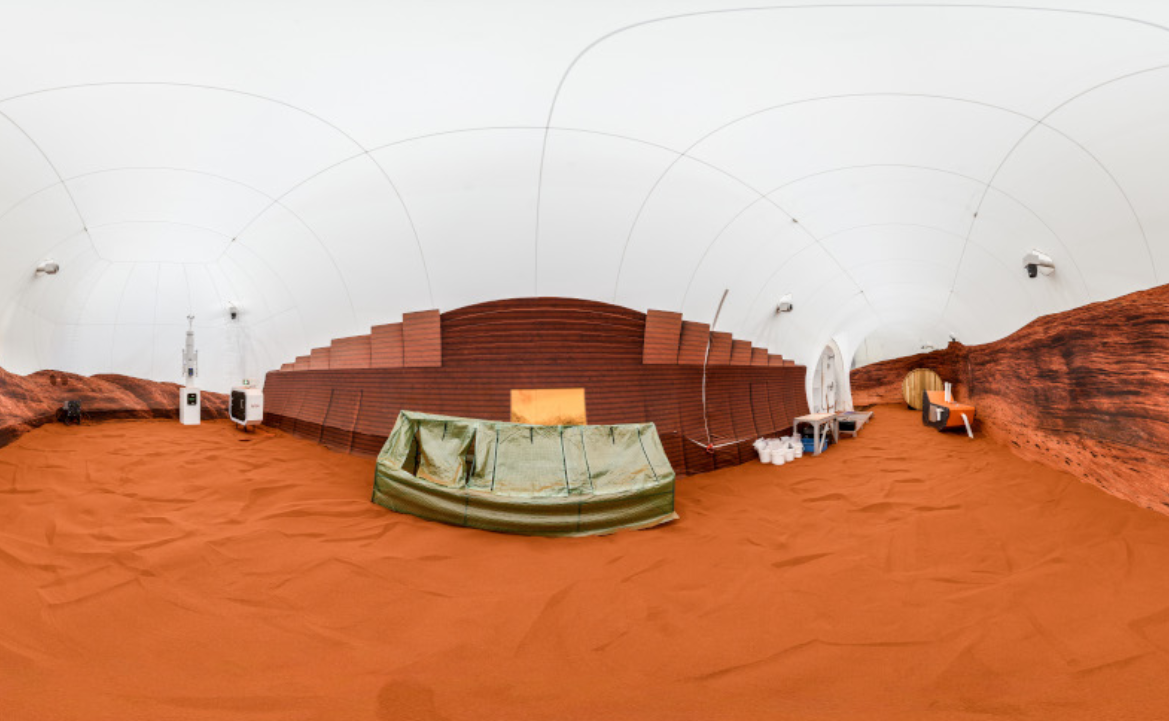
A 360-deg. view of the sandbox portion of CHAPEA
HOUSTON—NASA soon will choose four volunteers to enter its new Mars Dune Alpha, an elaborate, simulated red planet habitat at Johnson Space Center where they will begin the first of three yearlong Mars mission simulations.
Crew Health and Performance Exploration Analog (CHAPEA) personnel hosted an April 11 tour of the new 1,700 sq.-ft., 3D-printed simulated Mars habitat and its adjoining, 1,200-sq.-ft. simulated Mars landscape on which the participants will carry out notional spacewalks with Mars-like science objectives.
Prior to the Mars Dune Alpha open house, NASA on April 3 announced the names of the four astronauts selected for Artemis II, a mission around the Moon and back to Earth slated for late 2024. NASA’s second Artemis mission test flight and the program that follows are to lead to a sustained human presence at the Moon to prepare for the first human expeditions to Mars.
As Artemis II NASA astronauts Reid Wiseman, Victor Glover and Christina Koch are joined by Canadian astronaut Jeremy Hansen in June to begin formal training for the first post-Apollo era human lunar mission, four competitively selected and soon-to-be-announced volunteers are to take up residence in Mars Dune Alpha.
Over a yearlong stay, the Mars Dune Alpha tenants will be subjected to the anticipated challenges of life on the red planet, which experts across NASA formulated in late 2020, two agency officials said. They are Grace Douglas, the agency’s CHAPEA principal investigator and a genomics expert; and Suzanne Bell, NASA’s Behavioral Health and Performance Laboratory lead and a research psychologist.
Anticipated challenges are informed by more than two decades of a sustained human presence on the International Space Station (ISS). They include limited resources, equipment failures, and communications delays, as well as isolation from family and friends.
The one-year simulation is based on the surface stay portion of an estimated 2 1/2-year roundtrip Mars mission, perhaps getting underway in the 2030s, Douglas and Bell said. Just as anticipated for an actual mission, the crew simulation will include scientific research activities. They will culture some of their own food, including nutritious leafy greens and tomatoes; partake in daily aerobic and resistive exercise and work with virtual reality and robotic technologies to carry out their day-to-day activities.
The physical and mental health challenges faced by those occupying the isolated habitat will be closely monitored by the CHAPEA initiative. The habitat consists of four modest sleep stations, a bathroom and shower, a food preparation and dining area, workout facilities, a work area and an adjacent “sand box” for planned hours-long Martian spacewalk simulations.
Unlike the ISS, where the time delays in communication between the astronauts and their Earth-based Mission Control Centers in Houston and Moscow are brief, the two-way time delays between astronauts on the Martian surface and their flight control teams will range up to 44 min.
The delay will be factored into the Mars Dune Alpha simulations, making self-reliance and teamwork major factors in assessing how the yearlong simulation unfolds.
“Our goal is to really understand with the restrictions we would put in place on Mars and in place here, with the performance that we are expecting them to be able to complete cognitively and physically—are we able to support them adequately with those restrictions?” Douglas said. “We really want to understand our risk trades ultimately. As we start designing and training for Mars missions, we want to support crew health and performance successfully.”
Apollo’s six Moon landings with a dozen astronauts between July 1969 and December 1972 have helped to remove some of the mystery from the first phase of Artemis, establishing a sustainable human lunar presence. But no human has been to Mars.
“Coming up with a very solid plan for what we see today as a very accurate Mars mission was very hard,” Douglas responded when asked about challenges that CHAPEA faced in structuring the lengthy simulations. “There are still a lot of unknowns for a human Mars mission.”
The first CHAPEA Mars mission participants, whom NASA plans to name soon, were selected over a 13-month process. Their applications were submitted in 2021 with NASA astronaut-like requirements. Those included U.S. citizenship or permanent U.S. residence; a master’s degree in a STEM field and two years of professional experience or 1,000 hr. of jet aircraft pilot in command experience. Doctors of medicine and osteopathy and graduate students in pursuit of a STEM field doctorates as well as applicants with relevant military experience also were eligible.
The finalists were required to undergo medical evaluations, psychological testing and psychiatric screening to determine suitability for the upcoming physical and mental challenge.
